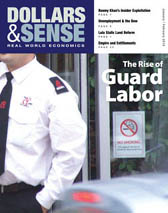
Bad News, Good News, and Class Conflict
This article is from the January/February 2010 issue of Dollars & Sense: Real World Economics, available at http://www.dollarsandsense.org

This article is from the January/February 2010 issue of Dollars & Sense magazine.
Subscribe Now
at a 30% discount.
Soft Economy? No Problem
First the bad news: The economy is weak. And now the good news: The economy is weak... Oddly, the same problem that worries many investors over the longer term is what encourages some for the short term: a soft economy. The reason is that an ailing economy requires the Federal Reserve to keep its short-term interest-rate targets near zero and continue pumping billions of dollars into the financial system.
—E. S. Browning, “For Stock Investors, Bad Economy Isn’t Bad,” Wall Street Journal, November 9, 2009
So the Journal has noticed that bad news on Main Street is good news on Wall Street. What’s next—will the Journal report that “the history of all hitherto existing societies is the history of class struggle”?
But the Journal reporters still have some work to do before they earn their merit badges in Marxism. First off, any economist worth her salt will tell you that stock prices are a leading economic indicator that goes up ahead of an economic recovery. Stock prices (measured in the chart to the right as the change in the Dow Jones Industrial Average) rise in anticipation of improved corporate profits, as investors want to buy in early. And the unemployment rate is a lagging economic indicator that goes down only after the economy heats up.
Employment lags because employers do not want to hire more workers until they are sure that the expansion will hold, and in the meantime they push the existing workforce harder and expand hours. So it’s not surprising to see stock prices and unemployment rates moving together as the economic recovery is just getting under way.
Second, the Journal attributes the correlation between rising stock prices and unemployment rates to the Fed’s prodigious expansion of the money supply that pushed down interest rates. With few other good investment outlets, the plentiful supply of funds found its way into the stock market igniting a speculative boom.
There is something to that. Low interest rates have especially benefited hard-hit financial corporations. Cheap money brought these banks back to life. Rock-bottom interest rates widened their margins, the gap between short-term rates at which banks borrow and long-term interest rates at which they lend, boosting bank profits. And the price of their stocks has risen at twice the rate of the nearly year-long upswing in the market.
But that is only part of the story. As any class-conflict theorist would quickly add, the Fed could not have cut interest rates so drastically unless the threat of inflation had been tamed—especially the threat of higher wages, the largest cost of most corporations. Stock prices are up because the weak economy has put a damper on wage increases and allowed corporate cost-cutting to boost profits. As the 1970s demonstrated, inflation wipes out stock market gains.
Nothing knocks the stuffing out of workers’ ability to push for higher wages more than a weak economy. Double-digit official unemployment rates have battered workers’ bargaining power. As of October 2009, there were 6.3 officially unemployed workers for every job opening, the highest number since the Bureau of Labor Statistics began tracking that ratio in 2000. This is surely not the time to be asking the boss for a raise.
Don’t expect the economic recovery to break the correlation between rising stock market gains and unemployment rates anytime soon by lowering unemployment rates—unless the stock market boom fizzles. A jobless recovery, a hallmark of the economic downturns of the last two decades, has transformed the correlation between rising unemployment rates and stock market prices to something other than a statistical oddity.
Even though the economy has begun growing again, the prospects for more jobs anytime soon remain bleak. Following the 2001 economic downturn, the U.S. economy continued to lose jobs for another two years and it took more than three years before the economy had replaced the jobs lost in the recession. If the current sluggish recovery creates jobs at the same pace as the last recovery, it would take 86 months, or more than 7 years, to replace the far greater number of jobs lost in this downturn than in the 2001 recession.
Now that’s enough to make anyone, even a Journal reporter, a Marxist.
